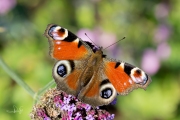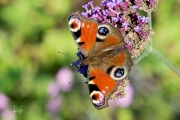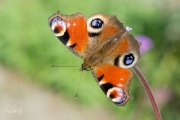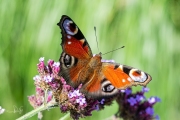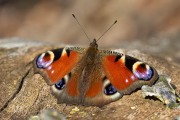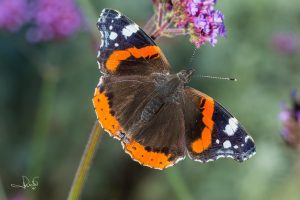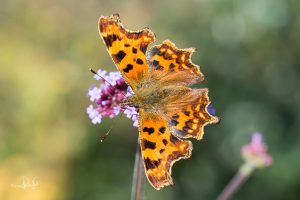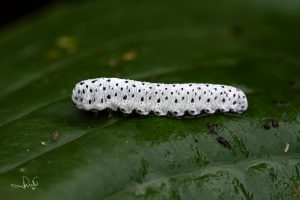While we have already experienced the first frost and our pond has frozen over, I am writing a blog about the peacock (Aglais io). Not the graceful bird with its impressive tail feathers but the butterfly. It will soon become clear why. With 34 species, I have already seen about two-thirds of the butterfly species you can see in the Netherlands. Even though the peacock is very common, in my opinion it’s one of the most beautiful of those 34 butterflies. It is a species that you can see flying around almost everywhere from March to October but you may encounter a peacock on sunny days in November or even December too when you may find it fluttering around quietly and feasting on the last rays of sunshine.
Hibernator
Recently, someone on Facebook asked if it’s normal to see a peacock in your house. This is nothing special though, the peacock is after all a hibernator. At the end of the mating season it looks for a nice warm and dark spot and folds its delicate wings together. To then turn its thermostat down completely and immerse itself in a long hibernation. You can come across them in sheds and attics during this period. When the first warm rays of the sun reappear in spring, the peacock emerges from its wintering spot. Some of them even dare to appear when there is still snow. These hibernators are usually the first butterflies see very early in the season, in the period from March to May. After that the mating season starts and the males begin to define and defend a territory. These are not as clearly defined as we sometimes see in birds and mammals, but the male peacocks keep a close eye on it from a nice spot in the sun.
From egg via caterpillar to butterfly
As soon as a female presents herself, she is chased by males in the hope of mating. Once the mating is done, the female starts laying eggs, mainly on the underside of nettle leaves in groups of 50 to a few hundred eggs. In a favourable year this can occur up to three times and the female will lay 800 to 1000 eggs at a time. After a few weeks, depending on the temperature, the black caterpillars hatch and immediately attack the leaves of the nettle. These caterpillars stay together and build a nest of silk. In the meantime, they keep getting bigger to about 4 centimeters and therefore have to exuviate a few times. When the caterpillars are too big to stay together in the silk nest, they go separate ways. After a month they start looking for a quiet place to pupate. The pupal stage lasts only a week and during that time a small miracle takes place in the cocoon.
Up to ten months
What a week earlier was a black, spiny caterpillar, now is a beautifully coloured butterfly crawling out of its cocoon. At first a bit disheveled, but after the wings have been pumped up and hardened in the sun, a new peacock flies into life. Looking for nectar, but also a partner to mate with. It will have the time for that, because peacocks can get old, at least for butterflies. Where some other species die after a few weeks or sometimes only days, a peacock can live up to ten months. After June it is the new generation that shows itself. These are more beautiful than the ones from spring, because their wings are still new and completely intact and not yet damaged and faded as you see with older butterflies. In Dutch we call that “flown off”.
Literally a beautiful butterfly
The peacock has beautiful colors on its upper wings, the spots of which immediately catch the eye on all four wings. After all, that is how it got its name. The Aglais from its scientific name also refers to the splendour of this butterfly: it is derived from the Greek aglaos, which means splendour. You couldn’t make it up any better. With closed wings, however, the butterfly is less noticeable, the underside of the wings look like a withered leaf and by no means has the bright colours like the topside. The eyes on the wing serve as a deterrent against birds, among other things. If the butterfly feels attacked, it immediately flips open its wings, hoping it will impress enough to repel the attack. Often in vain, sometimes the bird is aiming at the “eyes” and the delicate wing of the butterfly is damaged. Yet they still manage to maintain themselves reasonably well. You can even encounter butterflies with a piece taken from their wing.
Generally represented
One of the most important host plants of the peacock is the common nettle (Urtica dioica). The host plant is the plant on which the butterfly deposits the eggs. They are at least as important as the nectar plants such as hemp-agrimony (Eupatorium cannabinum), butterfly-bush (Buddleja davidii) and Carduus. So if you want to have a lot of butterflies in your garden, keep nettles in the garden or nearby. Since the nettle is very common, it is not surprising that you can encounter the butterfly in our entire country and in almost every biotope. Whether in the field, in the countryside, on a construction site or in a city garden, you see the peacock everywhere. Even in the middle of winter.
Sources:
This item was originally published in Dutch on December 7th 2016



